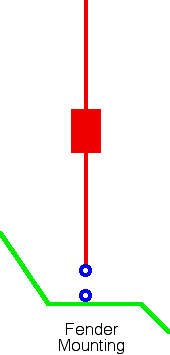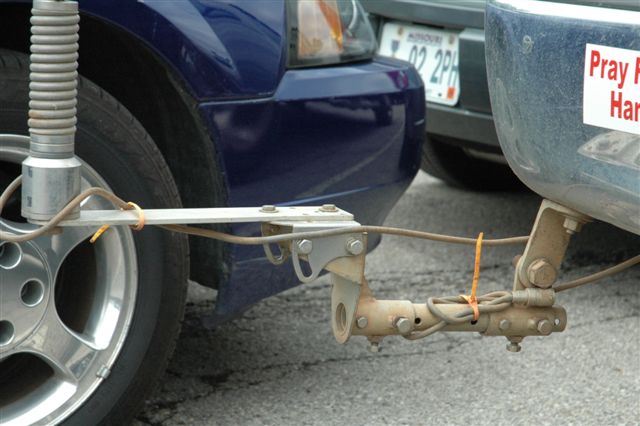I just purchased a Cobra 75WXST for my '97 Tacoma. I am wondering what antennas do you guys use and where do you have them mounted. I am leaning towards mounting it on a bed rear light bar that is mounted on top of the bed rails. But, I am thinking that I might need to get a no plane ground antenna, because I don't think it will have a good enough ground. I am, also, thinking about mounting it on the front, along the hood channel on the driver's side, since it could possibly be a better grounded location.
You are using an out of date browser. It may not display this or other websites correctly.
You should upgrade or use an alternative browser.
You should upgrade or use an alternative browser.
cb antenna and mount location
- Thread starter cr500taco
- Start date
MOguy
Explorer
The best place is as high as possible and the most metal for you ground plane, probably the top of your roof. However that may not be the best place if you are worried about clearance issues.
Mount or ground to bare metal.
Instead of no ground plane antenna I would mount the antenna where you want it and then run a ground from the antenna mount to the body or bed.
Fenders, tailgate, doors or anything that attach to your body may not make a good ground.
Mount or ground to bare metal.
Instead of no ground plane antenna I would mount the antenna where you want it and then run a ground from the antenna mount to the body or bed.
Fenders, tailgate, doors or anything that attach to your body may not make a good ground.
Last edited:
nitro_rat
Lunchbox Lockers
********** dab in the middle of the roof is the best spot. Second best is probably one of the corner fender mount jobs that puts the antenna at the base of the a-pillar, drivers side. Mounting the antenna to the bed rail parallel to the back of the cab will A) block reception of signals from opposing traffic and B) will see a large amount of your transmit wattage absorbed by the parallel metal surfaces of the cab of the truck rather than going out on the airwaves. Such an installation will also be very directional, i.e. you will send and receive much better to those behind you than those ahead. With the a pillar installation the pillar is at an angle to the antenna so the transmit energy is not absorbed by a parallel metal surface. Also it is generally desirable to have your best signal (full unobstructed view of the antenna) to oncoming traffic for bear reports, etc.
The exception to all of the above is if you run a 102" whip antenna. It will out perform pretty much anything else regardless of where you mount it...
Without exception I would ensure a good ground from the base of the antenna to the frame of the vehicle.
The exception to all of the above is if you run a 102" whip antenna. It will out perform pretty much anything else regardless of where you mount it...
Without exception I would ensure a good ground from the base of the antenna to the frame of the vehicle.
nemobuscaptain
New member
If you expect it to work beyond the front of the convoy to the rear, you really DO need to pay attention to the location of the antenna. Remember you are only working with 4 watts if you are running a legal CB. Moving the antenna from the hood to the fender probably is a 3.0 db loss (or roughly lossing half your power). If it isn't a 108 inch (1/4 on 27 mhz) antenna, you are probably losing 3-5 db also (cutting your power to half or even 1/4). THESE ARE CUMULATIVE. Those super short antennas, like the 3 feet versions are probably cut the power in half again. So if you are running a 3 foot antenna on your fender or bumper with a 4 watt radio, you are probably radiating no more than 1 watt of power. Maybe even 0.25 to 0.50 watts. It does make a huge difference. In the radio world, EVERYTHING is about the antenna.Instead of no ground plane antenna I would mount the antenna where you want it and then run a ground from the antenna mount to the body or bed.
Fenders, tailgate, doors or anything that attach to your body may not make a good ground.
Look, the antenna DEFINITELY needs a good ground, but it also needs a good ground plane too. These are NOT the same concept and a ground does not replace a ground plane. Here's an article explaining this with some excerpts to get you started. http://www.k0bg.com/ground.html
What is a Ground Plane?
A vertical antenna is nothing more than half of a dipole. A monopole in other words. However, since RF must return to its source, we need something to replace the missing half. It is what we call this missing half, that is at issue.
In a base station installation, we typically have a radial field. That radial field can have a variety of different configurations, depending on the specific installation. But we don't have that luxury in a mobile. So if we don't have a radial field, what do we have?
 For one, we have the body of the vehicle. That body does capacitively couple to the surface under the vehicle, but technically, it isn't a radial field. Nor is there one built into the surface under the vehicle. It is sort of like installing a base station vertical using nothing more than a pipe driven into the dirt (ground). The word ground brings up yet another issue.
For one, we have the body of the vehicle. That body does capacitively couple to the surface under the vehicle, but technically, it isn't a radial field. Nor is there one built into the surface under the vehicle. It is sort of like installing a base station vertical using nothing more than a pipe driven into the dirt (ground). The word ground brings up yet another issue.Is the ground in question a DC ground, an RF ground, or a Ground Plane? The truth is, it can be any or all, which leads far too many to confuse one type of ground with the others! This is, in fact, the crux of the problem; What is a Ground Plane?
Well, DC and RF grounds are easily explained, and the ARRL Handbook does a marvelous job of doing so. But how do we best describe a (mobile) Ground Plane? It certainly isn't a counterpoise, although a lot of folks use that term. It isn't a radial field or a ground strap to the nearest hard point either—a common, but incorrect assumption!
So the original question is still in limbo; How do we best describe the elusive missing half of our monopole? Perhaps if we look at the issue from a bit different angle, the term Ground Plane might not be such a wishy-washy term after all.
Webster defines a plane, as a flat and level, horizontal surface. Whether we're talking about a radial field, or the body of a vehicle, that description fits! For example, one rule we need to follow, is to place as much metal mass directly under our vertical antenna as possible, like the drawing at left depicts (what's along side doesn't count!). In fact, this is exactly what a radial field does—place lots of metal directly under the antenna! The missing half, in other words! And we also need to make sure the coax's shield (ground) connection is congruent with the start of this flat and level, horizontal surface. Hence the term Ground Plane, or more correctly, Grounds Plane isn't so far fetched after all.
....
Mounting Location Issues
The best place to mount an HF mobile antenna, is in the center of the roof. This places it as far away from the surface the vehicle is sitting on, and as far away from the vertical surfaces of the vehicle as possible. With respect to system losses, any other position on the vehicle will exhibit more loss. And as stated above, DC or RF round straps will not negate this premise!
To restate the above, low mounting heights increase ground losses. The reason is, a goodly portion of the return current is forced to flow in the lossy surface under the vehicle, rather than through the vehicle's less lossy superstructure. How much affect this has on efficiency depends on a lot of factors.... Remember the key to maximum efficiency is placing as much metal mass directly under the antenna as possible! That certainly isn't the case in the right photo!

End of quote
That ham antenna on a bracket from the rear bumper probably looks familiar right? is it really that different from all the CB antennas we see mounted to a rear bumper or rear tire carrier? It isn't RF wise.
I know, I know, plenty of your CB buddies have them mounted low and they work, sort of. Realize that you are probably reflecting about 1/4 (AT BEST) of the power you COULD be, if you actually consider that CB (or other antenna) an emergency comm system.
1stDeuce
Explorer
I have a "Little Will" Wilson mag mount that has served me for years. I sits in the middle of the roof of the truck most of the time, where it gets great reception. If I need better clearance, or put the camper in, I move it down to the hood or bumper, where reception is not bad or pretty bad, respectively. I've been through probably 5 fiberglass whips on various vehicles, while that Wilson 500 is still going strong after being beat through the brush for years.
I don't do drive through car washes, but if you do, a mag mount can be taken down so it doesn't get broken. Not so with hard mounted antennas...
I don't do drive through car washes, but if you do, a mag mount can be taken down so it doesn't get broken. Not so with hard mounted antennas...
Similar threads
- Replies
- 1
- Views
- 553
- Replies
- 3
- Views
- 715
